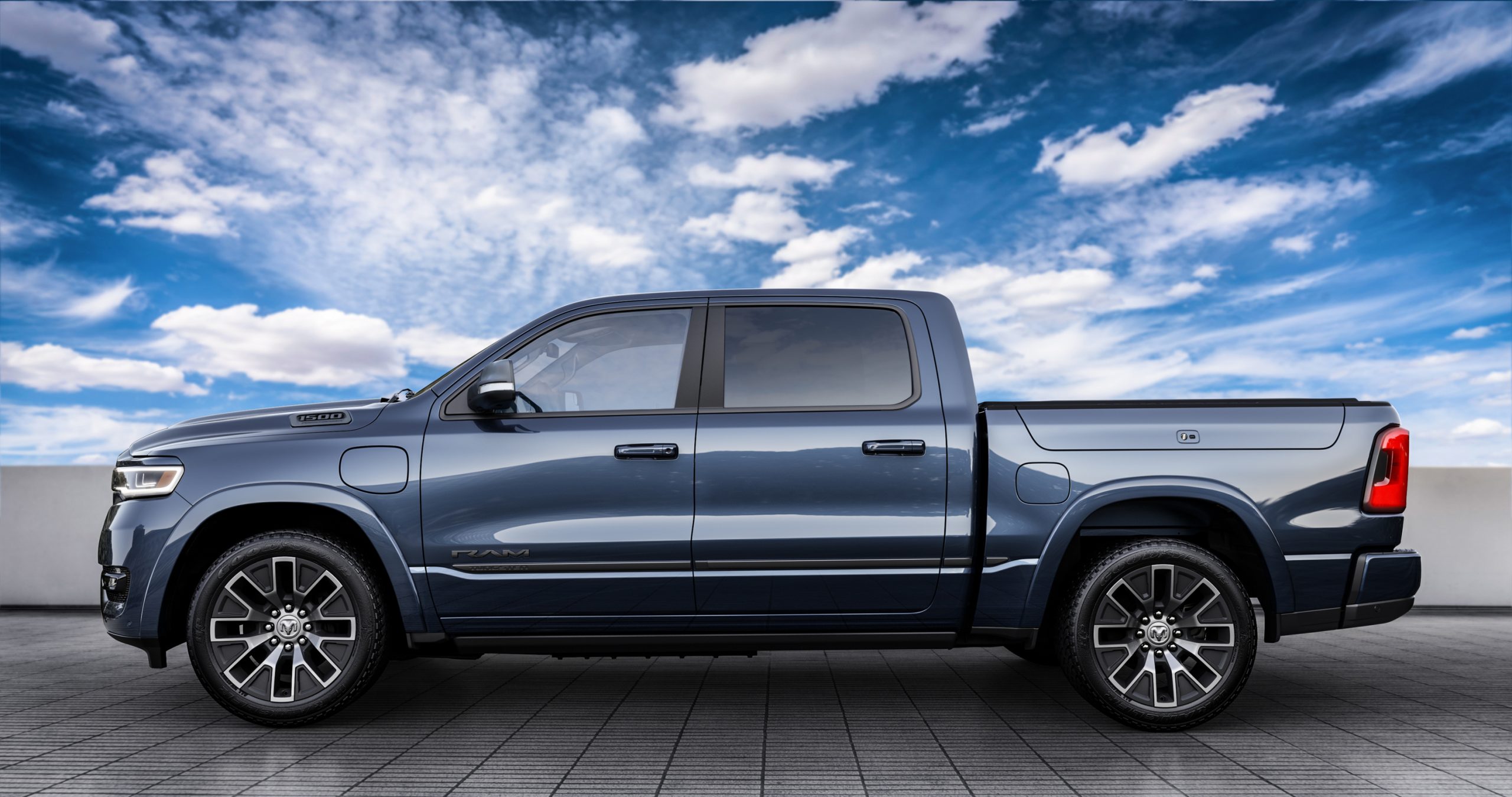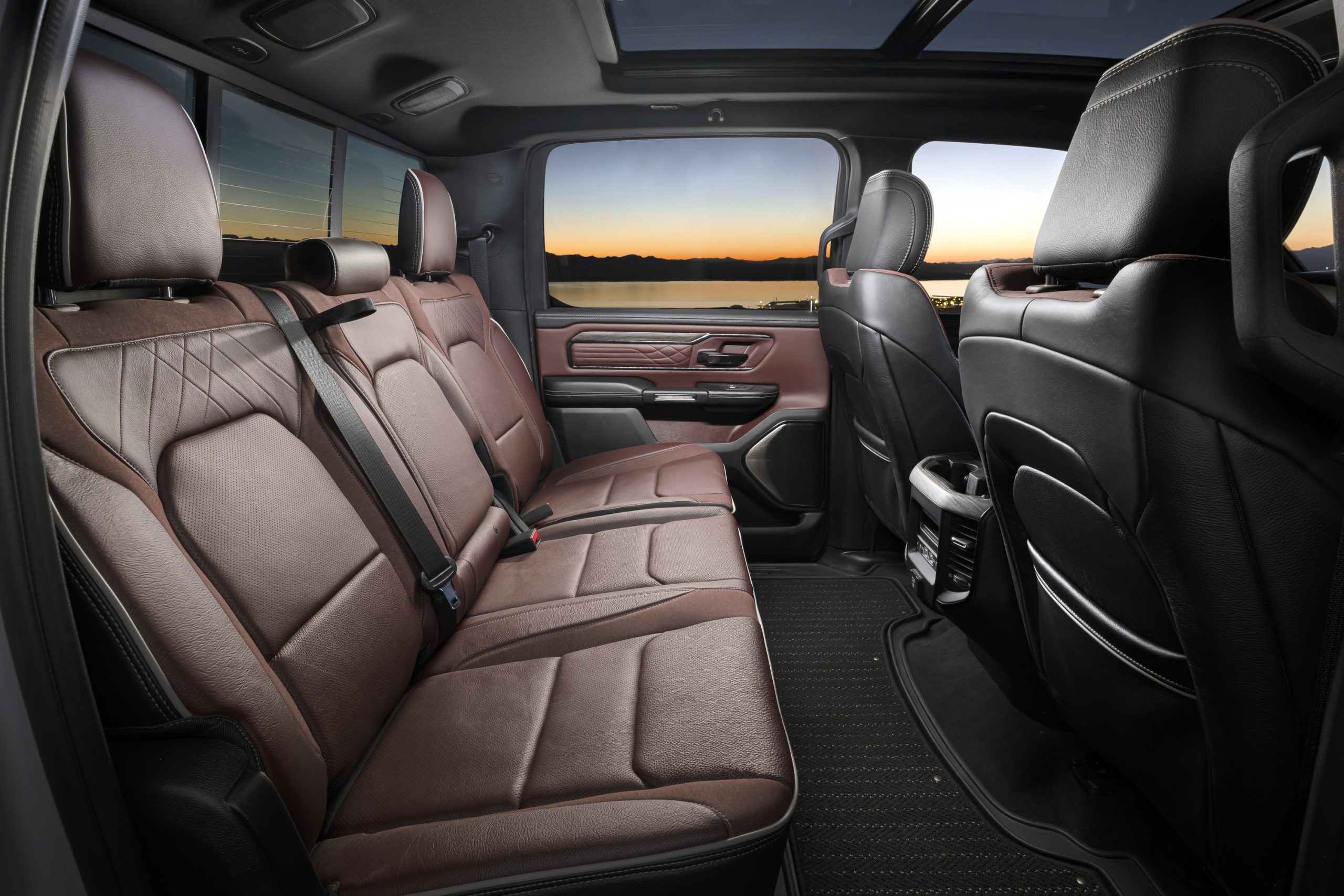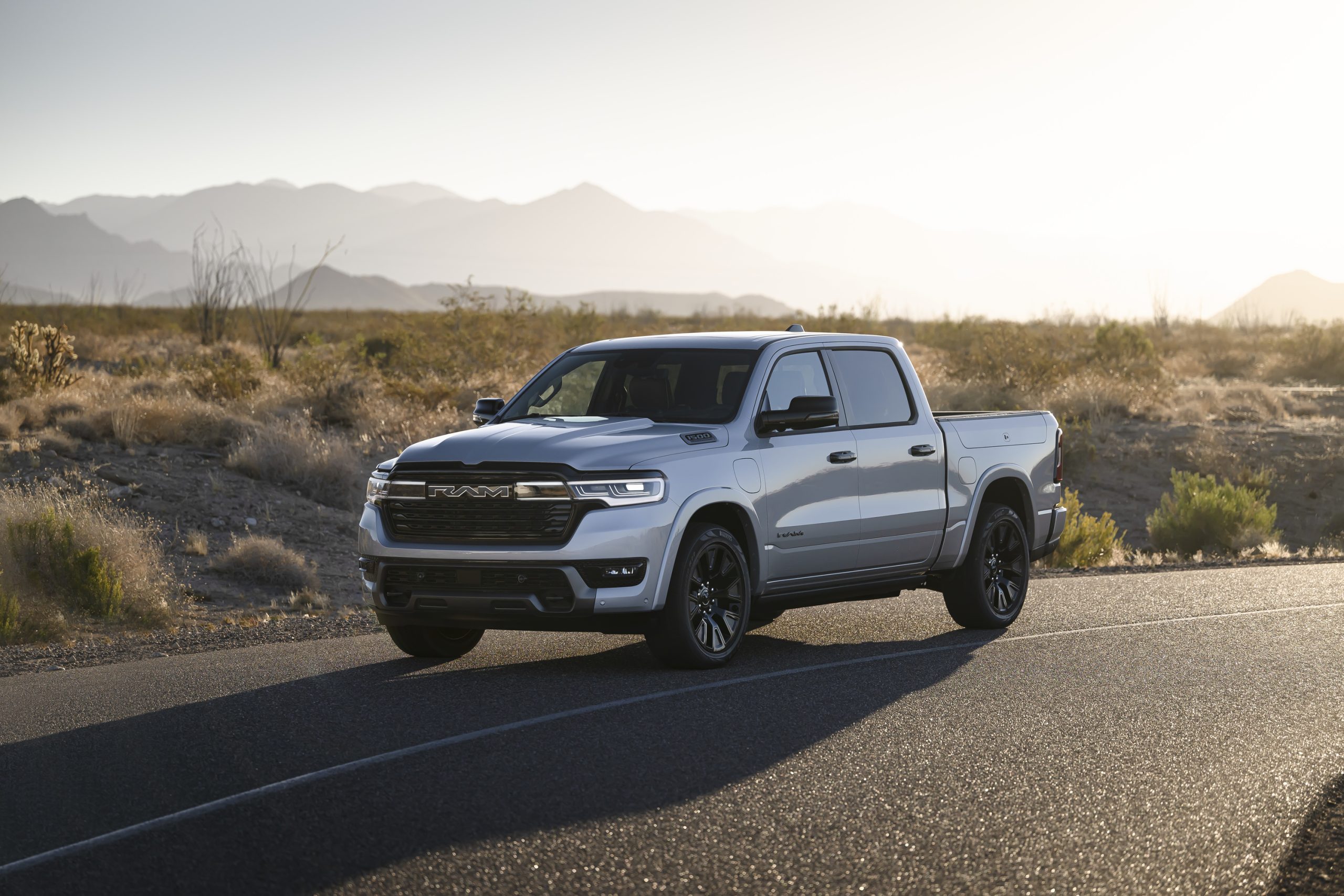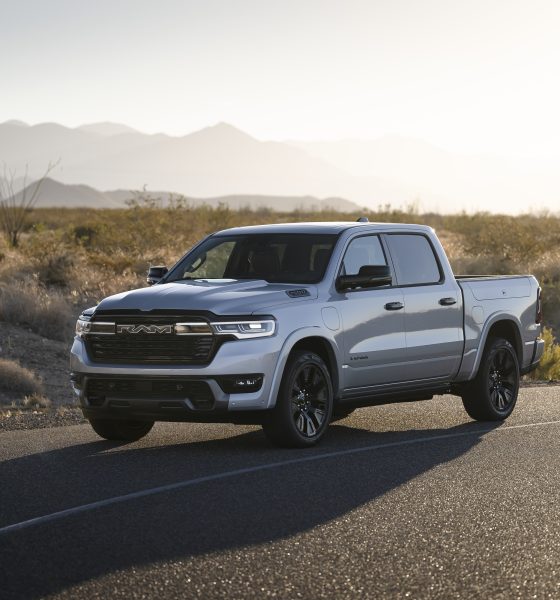Stellantis has unveiled its new 2025 Ram 1500 Ramcharger, which features both battery-electric motors and a gas engine to recharge on the go.
According to a press release shared by Stellantis on Tuesday, the Ram 1500 Ramcharger will feature 250-kW front and 238-kW rear electric drive modules, as powered by a 130-kW generator and a 92-kWh battery. Between these and a 3.6-liter, V6 gas engine, the truck is expected to offer up to 690 miles of range, with the gas-powered hardware turning on to charge the truck once the battery runs out of power.
The partially electric truck will essentially function like a plugin hybrid electric vehicle (PHEV).
The Ramcharger also boasts a 0-60 mph acceleration of 4.4 seconds, along with 663 horsepower, 615 lb.-ft. Of torque, and up to 14,000 pounds of towing with payloads up to 2,625 pounds. The company says that the truck will be able to gain 50 miles of range in just 10 minutes using 400-volt fast charging at a capacity of up to 145 kW.
“With unlimited battery-electric range, the Ram 1500 Ramcharger is the pinnacle of the light-duty pickup truck segment and the ultimate electric truck,” said Tim Kuniskis, Ram brand CEO for Stellantis. “The new Ramcharger is a beast of a light duty – 663 horsepower, 615 lb.-ft of torque, 4-second 0-60 mph, 14,000 lbs. of towing… and zero need for a public charger.”
The partially electric pickup will be built on the Stellantis STLA Frame platform, and it will feature advanced driver assistance system (ADAS) capabilities, including the Level 2 hands-free highway assist. The vehicle is also set to include regenerative driving modes, a set of e-shifter buttons, a 1,228-watt Klipsch audio system with 23 speakers and more.
It will include adjustable driving modes and air suspension with the following settings:
Driving Mode settings for the 2025 Ram 1500 Ramcharger
- Auto
- Sport
- Tow
- Snow
- Off-Road
Air Suspension settings for the 2025 Ram 1500 Ramcharger
- Entry/Exit
- Aero
- Normal
- Off-Road 1
- Off-Road 2
The electric pickup will also include a 400-volt DC fast-charging port on the front quarter panel on the driver’s side. It also has a power tailgate and interior features such as a 14.5-inch front touchscreen, a 12.3-inch instrument cluster, a 10.25-inch passenger screen, a digital rearview mirror, a Head-Up Display (HUD) and more.
Those who are interested in buying the Ram 1500 Ramcharger can reserve a spot here with just a $100 refundable membership charge.
You can see a few more images of the forthcoming Ramcharger below.

Credit: Stellantis

Credit: Stellantis

Credit: Stellantis

Credit: Stellantis
Earlier this year, Stellantis announced the fully electric Ram 1500 REV, which reportedly ran out of reservation spots a little over a week after it went live. The upgraded trim of the electric pickup is expected to have a 229 kWh battery pack offering up to 500 miles of range, while the standard range option will feature a 168 kWh battery with up to 350 miles of range.
The announcement arrives amidst increased competition in the electric pickup sector, including direct Ram 1500 REV competitors like the Ford F-150 Lightning, the Chevy Silverado EV and the Rivian R1T. Although it’s a less conventional electric truck, the Tesla Cybertruck will also begin deliveries later this month.
Lucid Motors adopts Tesla’s NACS, leaving only Volkswagen and Stellantis
What are your thoughts? Let me know at zach@teslarati.com, find me on X at @zacharyvisconti, or send your tips to us at tips@teslarati.com.

Elon Musk
Elon Musk and Tesla AI Director share insights after empty driver seat Robotaxi rides
The executives’ unoccupied tests hint at the rapid progress of Tesla’s unsupervised Robotaxi efforts.

Tesla CEO Elon Musk and AI Director Ashok Elluswamy celebrated Christmas Eve by sharing personal experiences with Robotaxi vehicles that had no safety monitor or occupant in the driver’s seat. Musk described the system’s “perfect driving” around Austin, while Elluswamy posted video from the back seat, calling it “an amazing experience.”
The executives’ unoccupied tests hint at the rapid progress of Tesla’s unsupervised Robotaxi efforts.
Elon and Ashok’s firsthand Robotaxi insights
Prior to Musk and the Tesla AI Director’s posts, sightings of unmanned Teslas navigating public roads were widely shared on social media. One such vehicle was spotted in Austin, Texas, which Elon Musk acknowleged by stating that “Testing is underway with no occupants in the car.”
Based on his Christmas Eve post, Musk seemed to have tested an unmanned Tesla himself. “A Tesla with no safety monitor in the car and me sitting in the passenger seat took me all around Austin on Sunday with perfect driving,” Musk wrote in his post.
Elluswamy responded with a 2-minute video showing himself in the rear of an unmanned Tesla. The video featured the vehicle’s empty front seats, as well as its smooth handling through real-world traffic. He captioned his video with the words, “It’s an amazing experience!”
Towards Unsupervised operations
During an xAI Hackathon earlier this month, Elon Musk mentioned that Tesla owed be removing Safety Monitors from its Robotaxis in Austin in just three weeks. “Unsupervised is pretty much solved at this point. So there will be Tesla Robotaxis operating in Austin with no one in them. Not even anyone in the passenger seat in about three weeks,” he said. Musk echoed similar estimates at the 2025 Annual Shareholder Meeting and the Q3 2025 earnings call.
Considering the insights that were posted Musk and Elluswamy, it does appear that Tesla is working hard towards operating its Robotaxis with no safety monitors. This is quite impressive considering that the service was launched just earlier this year.
Elon Musk
Starlink passes 9 million active customers just weeks after hitting 8 million
The milestone highlights the accelerating growth of Starlink, which has now been adding over 20,000 new users per day.

SpaceX’s Starlink satellite internet service has continued its rapid global expansion, surpassing 9 million active customers just weeks after crossing the 8 million mark.
The milestone highlights the accelerating growth of Starlink, which has now been adding over 20,000 new users per day.
9 million customers
In a post on X, SpaceX stated that Starlink now serves over 9 million active users across 155 countries, territories, and markets. The company reached 8 million customers in early November, meaning it added roughly 1 million subscribers in under seven weeks, or about 21,275 new users on average per day.
“Starlink is connecting more than 9M active customers with high-speed internet across 155 countries, territories, and many other markets,” Starlink wrote in a post on its official X account. SpaceX President Gwynne Shotwell also celebrated the milestone on X. “A huge thank you to all of our customers and congrats to the Starlink team for such an incredible product,” she wrote.
That growth rate reflects both rising demand for broadband in underserved regions and Starlink’s expanding satellite constellation, which now includes more than 9,000 low-Earth-orbit satellites designed to deliver high-speed, low-latency internet worldwide.
Starlink’s momentum
Starlink’s momentum has been building up. SpaceX reported 4.6 million Starlink customers in December 2024, followed by 7 million by August 2025, and 8 million customers in November. Independent data also suggests Starlink usage is rising sharply, with Cloudflare reporting that global web traffic from Starlink users more than doubled in 2025, as noted in an Insider report.
Starlink’s momentum is increasingly tied to SpaceX’s broader financial outlook. Elon Musk has said the satellite network is “by far” the company’s largest revenue driver, and reports suggest SpaceX may be positioning itself for an initial public offering as soon as next year, with valuations estimated as high as $1.5 trillion. Musk has also suggested in the past that Starlink could have its own IPO in the future.
News
NVIDIA Director of Robotics: Tesla FSD v14 is the first AI to pass the “Physical Turing Test”
After testing FSD v14, Fan stated that his experience with FSD felt magical at first, but it soon started to feel like a routine.

NVIDIA Director of Robotics Jim Fan has praised Tesla’s Full Self-Driving (Supervised) v14 as the first AI to pass what he described as a “Physical Turing Test.”
After testing FSD v14, Fan stated that his experience with FSD felt magical at first, but it soon started to feel like a routine. And just like smartphones today, removing it now would “actively hurt.”
Jim Fan’s hands-on FSD v14 impressions
Fan, a leading researcher in embodied AI who is currently solving Physical AI at NVIDIA and spearheading the company’s Project GR00T initiative, noted that he actually was late to the Tesla game. He was, however, one of the first to try out FSD v14.
“I was very late to own a Tesla but among the earliest to try out FSD v14. It’s perhaps the first time I experience an AI that passes the Physical Turing Test: after a long day at work, you press a button, lay back, and couldn’t tell if a neural net or a human drove you home,” Fan wrote in a post on X.
Fan added: “Despite knowing exactly how robot learning works, I still find it magical watching the steering wheel turn by itself. First it feels surreal, next it becomes routine. Then, like the smartphone, taking it away actively hurts. This is how humanity gets rewired and glued to god-like technologies.”
The Physical Turing Test
The original Turing Test was conceived by Alan Turing in 1950, and it was aimed at determining if a machine could exhibit behavior that is equivalent to or indistinguishable from a human. By focusing on text-based conversations, the original Turing Test set a high bar for natural language processing and machine learning.
This test has been passed by today’s large language models. However, the capability to converse in a humanlike manner is a completely different challenge from performing real-world problem-solving or physical interactions. Thus, Fan introduced the Physical Turing Test, which challenges AI systems to demonstrate intelligence through physical actions.
Based on Fan’s comments, Tesla has demonstrated these intelligent physical actions with FSD v14. Elon Musk agreed with the NVIDIA executive, stating in a post on X that with FSD v14, “you can sense the sentience maturing.” Musk also praised Tesla AI, calling it the best “real-world AI” today.










